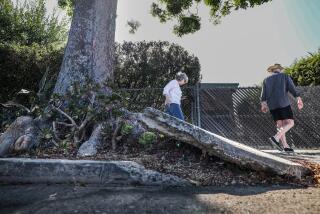Traffic Signs Route Anger Through Neighborhood
- Share via
No feud is as bitter as a neighborhood feud, and the feud between Crest Drive and Lake Drive in Encinitas is a pip.
For two years, residents of the two parallel streets have quarreled over whose street should bear the brunt of increasing traffic. Residents have passed petitions, packed the City Council chambers and written dozens of dueling letters to local newspapers.
“The shouting and screaming was bad enough, but then some of the city officials began receiving threats,” said Sheriff’s Detective Floyd Feese. Suspects were put under surveillance and homes were searched, but no arrests were made.
The issue has been whether the city should block off Crest Drive at one end to keep drivers from using it as a shortcut between El Camino Real and Interstate 5. To block Crest is to burden Lake with about 1,500 more cars a day.
A divided council has sided with Crest, but the anger remains. “If anything, I think the passions are getting hotter,” said Councilwoman Gail Hano.
Council members argue that the wider Lake was built as a “collector” street, and that the narrower Crest was not. Lake residents accuse the council of bowing to political and legal pressure and providing Crest residents with a private street at their expense.
Of the two streets, Crest is easily the more desirable, with large lots, a view of the ocean and tall trees on both sides of the street providing a leafy canopy. Lake has apartment buildings, greenhouses and modest tract homes.
Crest is east of Lake and slightly elevated, allowing homeowners on the west side of the street to look down on homes along Lake Drive, a bit of topography ripe with political symbolism. When the council voted to block off Crest Drive to through traffic, it increased the feeling among Lake homeowners that they were being treated like poor relations.
A lawsuit was filed by a Lake resident to block the closure. An appeal was made to the San Diego County Grand Jury. There were more letters, petitions and speeches.
When traffic signs were erected last fall--Stop, Wrong Way, Do Not Enter, No Outlet--a Lake resident was cited by deputies for honking his car horn and squealing his tires in protest. The signs disappeared and were replaced.
The signs disappeared again and last week were replaced with vandal-proof designs more commonly found in the vandalism-plagued inner city than in an affluent suburb. Mort August, the city’s public works director, hopes the concrete-anchored, heavy-bolted metal signs will do the trick, but he guarantees nothing.
“The people are telling us they’re still mad at what we’ve done,” August said. “I don’t see that changing very soon.”
Highly Charged Market
Just how hot is the North County real estate market?
Consider this: A couple from Walnut Creek in Northern California just purchased a $200,000 retirement home at Leisure Village Ocean Hills in Oceanside. Over the telephone, sight unseen. They provided the down payment with their Visa card.
An Urban Afterthought
For all its America’s Finest City chest-thumping, San Diego often has trouble being taken seriously on the national stage. Take the new, 346-page book by William Whyte, “City: Rediscovering the Center,” now receiving rave reviews as the definitive study of the American big city.
San Diego rates but one reference, although boosters will be relieved to know it’s an upbeat one to the city’s trolley cars: “When they come down the street, you perk up.”
By comparison, San Francisco is mentioned 15 times, Seattle nine, and Portland four, and dreaded Los Angeles gets seven full pages. Of course, not all the L.A. references are cheery.
Of the Bonaventure Hotel, with its silvery, cylindrical towers, Whyte writes: “From the opening day it was full of baffled people seeking directions, and the layout was so complicated that the giving of directions sounded like a who’s-on-first routine.”
More to Read
Sign up for Essential California
The most important California stories and recommendations in your inbox every morning.
You may occasionally receive promotional content from the Los Angeles Times.













